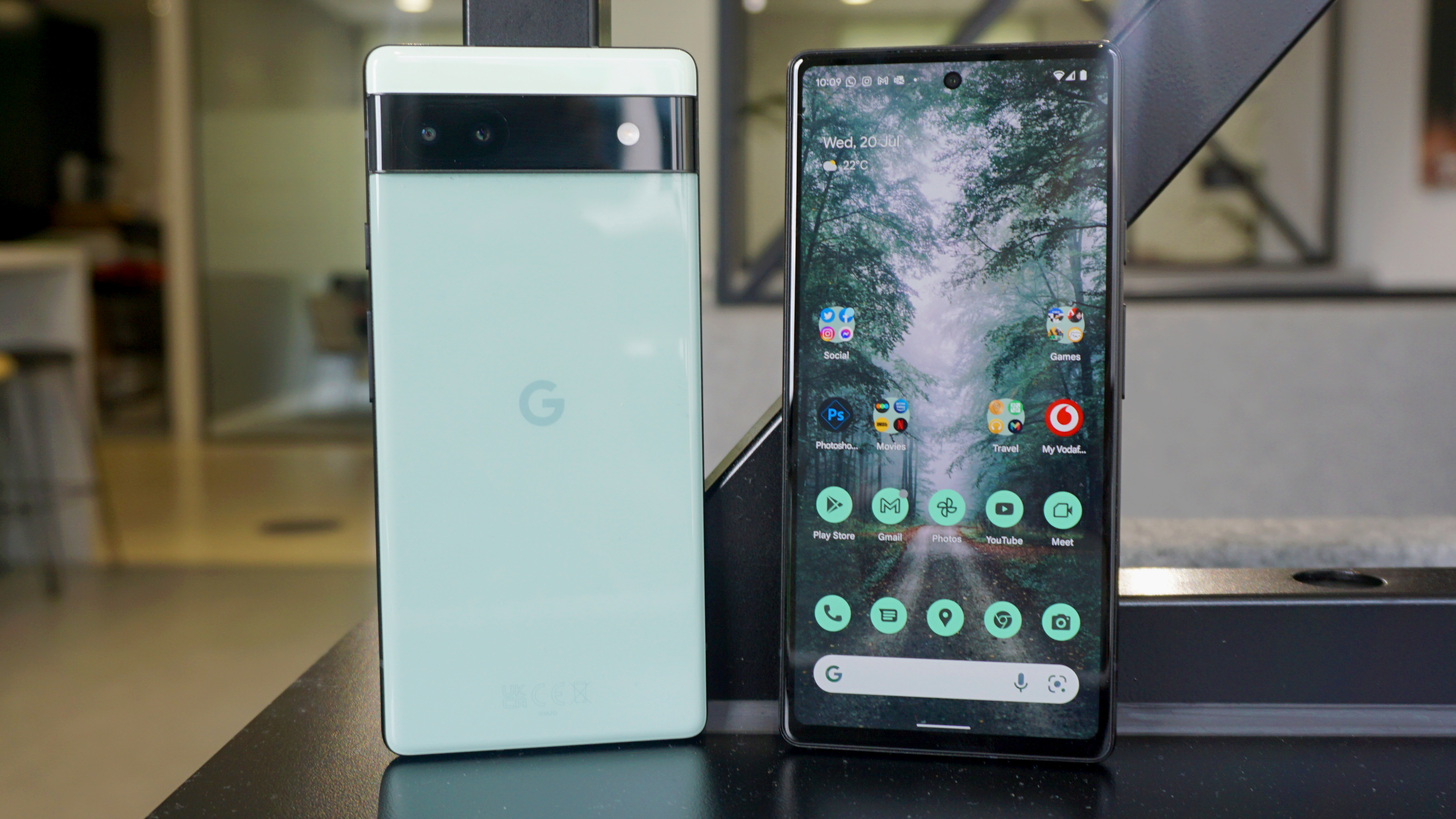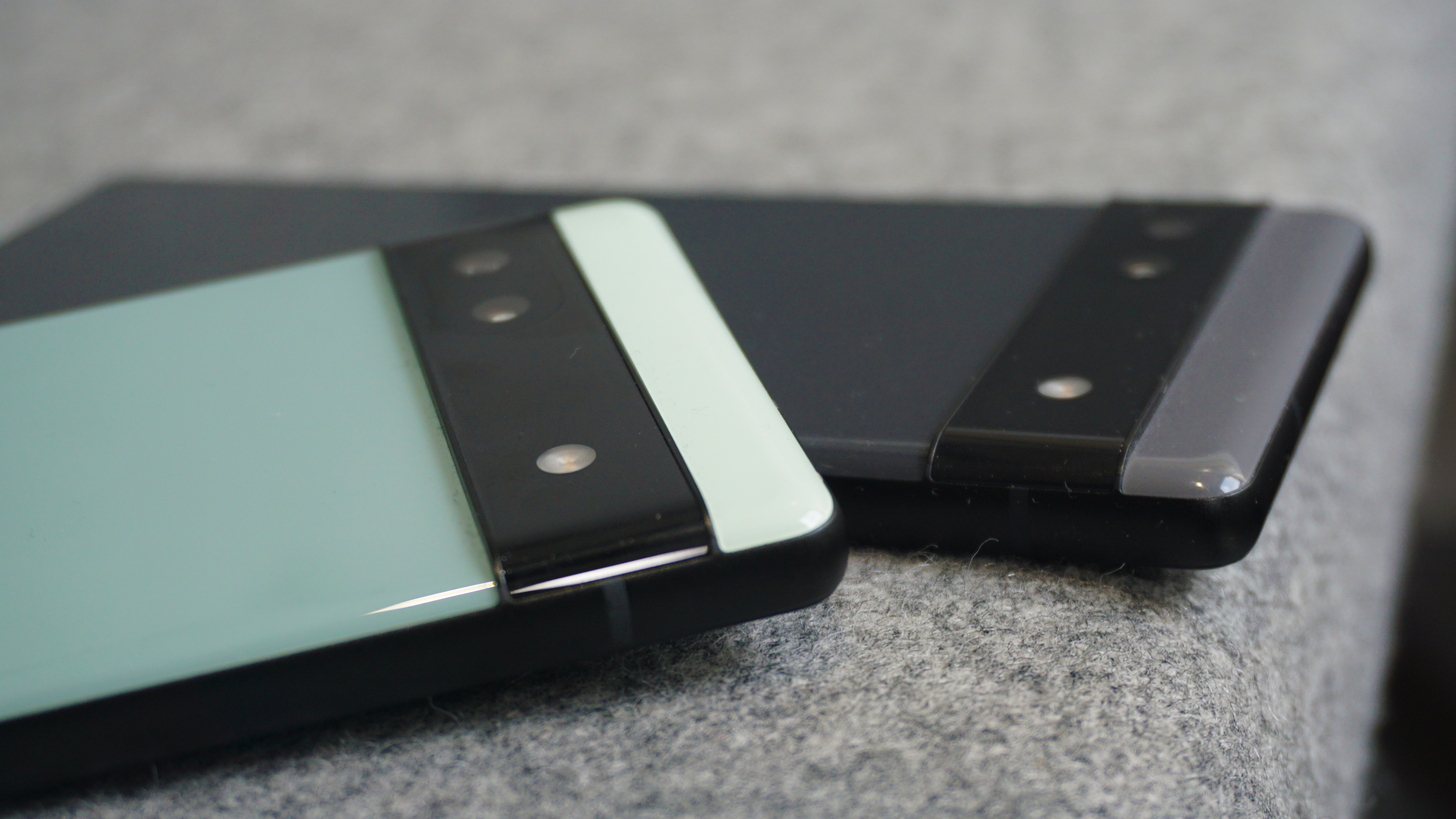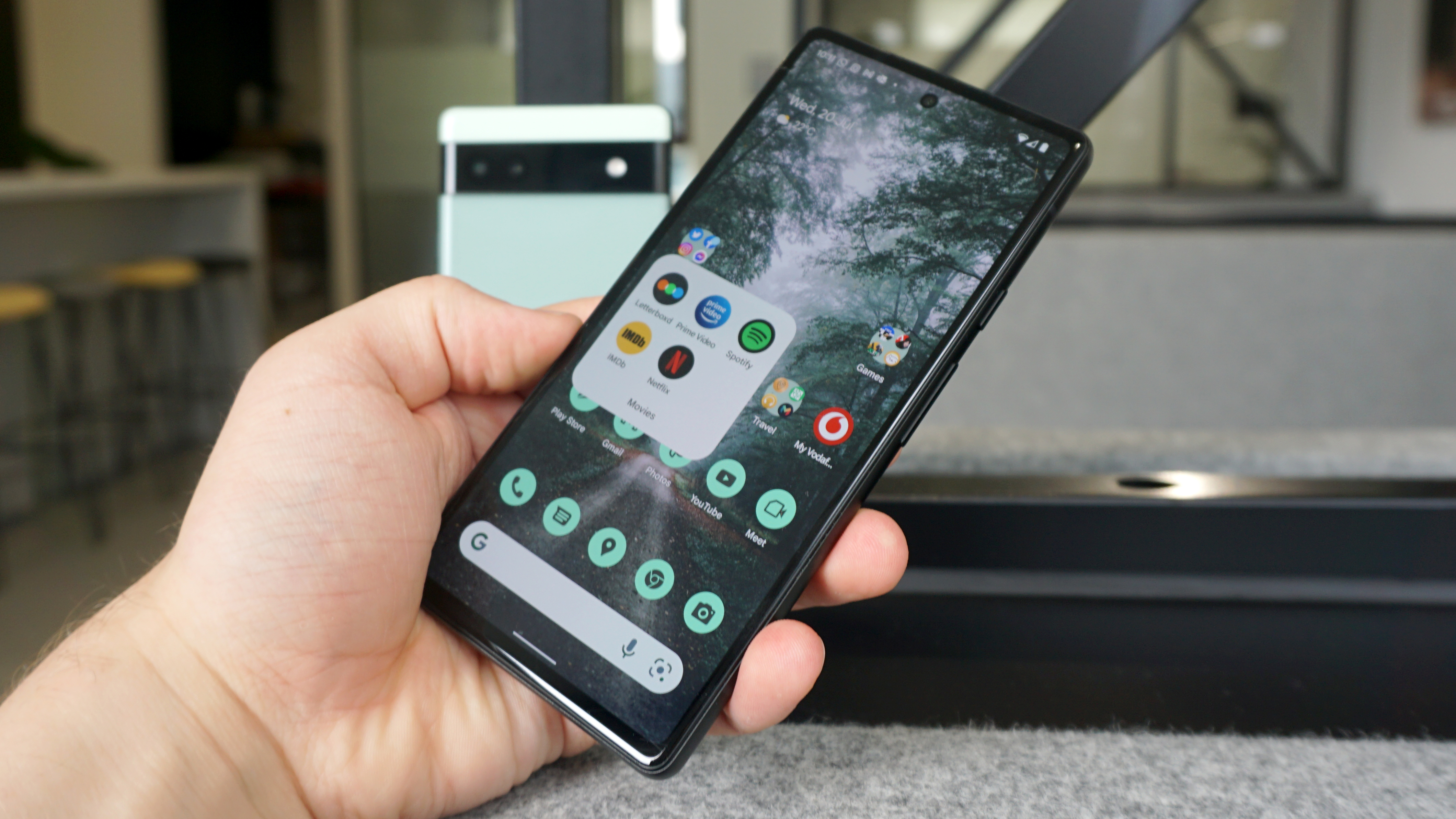
The iPhone 13 is more powerful than the Pixel 6a, more compact, its battery lasts a lot longer and it has a better camera. Throw in IP68 certification and wireless charging, and there really is no contest. It might be more expensive, but it's better value for money.
Pros
- Strong battery life
- Great design
- Powerful internals
Cons
- Minimal design changes
- No 120Hz screen
- No Ceramic Shield on rear
The Google Pixel 6a has a distinctive design, strong main camera, clean software and decent power - but it's outclassed by the iPhone 13 in every way. It does cost hundreds less, but weak battery life and slow charging really let this budget blower down.
Pros
- Snappy fingerprint scanner
- Relatively compact size
- Clean software
Cons
- Poor battery life
- Slow charging speed
Google’s latest mid-range smartphone, the Google Pixel 7a, finally hit shelves in May 2023, but the company's former affordable king, the Google Pixel 6a, still makes for a capable alternative to pricey flagships from the likes of Apple and Samsung.
But how does the phone actually stack up against Apple's previous-gen vanilla iPhone, the iPhone 13? Is it worth spending all that extra cash for the Apple name? We’ve now reviewed both phones, so let’s take a closer look.
In this guide, we pit the Google Pixel 6a against the iPhone 13, comparing features such as performance, display and, of course, price. Read on to find out which device comes out on top.
iPhone 13 vs Google Pixel 6a price and availability
The iPhone 13 hit shops on September 24, 2021. Prices started from $799 / £779 / AU$1,349 for 128GB of storage, moving up to $899 / £879 / AU$1,519 for 256GB and $1,099 / £1,079 / AU$1,869 for 512GB.
Having now been replaced by the iPhone 14, though, you can pick up the Galaxy S22 for a little less.
However, the same is true of the Google Pixel 6a, which arrived in shops on July 28, 2022 for a retail price of $449 / £399 / AU$749 (for the sole 128GB model). Following the release of the Pixel 7a, Google slashed the phone's price to $349 / £349 / AU$599, and you won't find the iPhone 13 anywhere near as cheap as that in 2023.
It’s a clear win for Google’s phone in the price department, then.
Sign up for breaking news, reviews, opinion, top tech deals, and more.
iPhone 13 vs Google Pixel 6a design
The Pixel 6a is one of the stand-out phone designs in its class, borrowing the two-tone rear panel and width-spanning camera ‘visor’ from the Pixel 6. Color choices are Chalk, Charcoal, and Sage.
It also benefits from a ‘tactile alloy’ frame, though the rear panel is formed of ‘3D thermoformed composite’, aka fancy plastic. As befits its higher price, the iPhone 13 design is more premium, with an aluminum frame and a glass rear.
Apple gives you a much wider range of color options, including Pink, Blue, Midnight, Starlight, and Product Red. The iPhone 13 also benefits from IP68 water and dust certification, which is superior to the Pixel 6a’s IP67.

The Pixel 6a is fairly small and lightweight, measuring 152.2 x 71.8 x 8.9mm and weighing 179g. However, it’s still bigger than the iPhone 13 in every regard, with Apple’s flagship measuring 146.7 x 71.5 x 7.65mm and weighing just 174g.
Google’s display notch is far less intrusive than Apple’s, that’s for sure. While the Pixel 6a makes do with an unobtrusive hole-punch selfie camera, the iPhone 13 notch takes a sizeable chunk out of the top of the screen.
Of course, the payoff for that is Apple’s superb Face ID facial recognition system. The Pixel 6a has to make do with an old-fashioned in-display fingerprint system, though it works well enough in our experience.
iPhone 13 vs Google Pixel 6a display
Both of these phones feature 6.1-inch OLED displays, and both underwhelm somewhat with their 60Hz refresh rates.
Arguably, this is a bigger omission from the iPhone 13, given its much higher price tag. Still, the Pixel 6a doesn’t escape censure, as it’s quite normal to find 120Hz displays for half the money in the Android world.

When it comes to resolution, the Pixel 6a goes for a standard 1080 x 2400 or FHD+ set-up, while the iPhone 13 gives you a bespoke 1170 x 2532. Apple’s screen is sharper, essentially, but there isn’t a massive amount in it.
While we found the Pixel 6a display to be perfectly decent, it simply isn’t as good as the iPhone 13 screen, which is brighter, sharper, and (with Dolby Vision support) richer.
It’s arguable that the difference in quality alone doesn’t justify that $350 / £380 / AU$600 price disparity, however.
iPhone 13 vs Google Pixel 6a camera
Both of these phones take very good pictures, but the iPhone 13 is competing with the Pixel 6, not the Pixel 6a.
Pixel cameras always punch above their weight, and that’s certainly true of the Pixel 6a. It might have the same humble 12.2MP f/1.7 dual-pixel main camera as older Pixel phones, together with autofocus and both optical and electronic image stabilization, but the pictures it captures are undeniably good.
That comes down to Google’s AI scene optimization, which is among the best in the business. You also get a 12MP ultra-wide camera.

While the Pixel 6a punches above its weight, we’re still only talking about a middleweight competing at cruiserweight. The iPhone 13, on the other hand, is a cruiserweight punching as hard as a heavyweight.
It too has a pair of 12MP sensors covering the wide and ultra-wide angles, but they’re of an altogether different caliber to the Pixel. The main sensor is much bigger than its Pixel 6a equivalent, capturing 1.7µm pixels compared to the Pixel’s 1.4µm. Together with a wider f/1.6 aperture, it simply sucks up way more light.

Combine that with Apple’s Sensor-Shift OIS technology, which keeps things freakishly steady, and the iPhone 13 is a low-light king.
Both phones come with their unique camera tricks. The Pixel 6a has Magic Eraser, which lets you remove unwanted background elements with a tap. The iPhone 13 gives you Photographic Styles, which lets you change the basic tone of snaps according to your taste.
Apple supplies a sharper 12MP selfie camera too, while Google gives you a slightly underwhelming 8MP equivalent.
iPhone 13 vs Google Pixel 6a specs and performance
While both of these phones take third place within their own range, they also both pack exactly the same power as their bigger and better brothers.
With the iPhone, that means the same 5nm A15 Bionic processor as the iPhone 13 Pro Max. With the Pixel 6a, that means the same 5nm Google Tensor chip as the Pixel 6 Pro.
We can give both phones a pat on the back for their punchy performance, but there’s no contest in a straight head-to-head. Apple’s chip blitzes all comers in most of the benchmarks that matter, whereas Google’s falls short of even other Android chips.

In our Geekbench 5 multi-core tests, the iPhone 13 scored 4688 to the Pixel 6’s 2837. We weren’t able to test the Pixel 6a, but it’s unlikely to have fared any better than its big brother.
In practical terms, the Pixel 6a was reasonably snappy in general navigation and day-to-day tasks, but it occasionally slowed down when we were taxing it too much. The iPhone 13, by comparison, was nigh-on flawless in all situations, launching apps in an instant, and swapping between apps with minimal pausing.
The Pixel 6a supplies 50% more RAM at 6GB, but that doesn’t mean much with the different ways in which iOS and Android operate
Talking of which, these two phones serve as showcases for the two major mobile operating systems – Android 12 for the Pixel 6a and iOS 15 for the iPhone 13. Neither phone has any annoying clutter, and both handle precisely as the manufacturer intended.
Indeed, if you have a strong preference in either direction – Apple’s iOS or Google’s Android – you can probably stop the deliberation right now. You already know which phone you’re going to get on better with.
iPhone 13 vs Google Pixel 6a battery
The Pixel 6a supplies a 4,410mAh battery, while the iPhone 13 gives you a much smaller 3,240mAh cell. Again, though, the different ways in which Android and iOS operate make a straight size comparison fairly pointless.
Indeed, in our experience, the Pixel 6a has considerably worse battery life than the iPhone 13. Our reviewer called the stamina of Google’s latest phone “abysmal”, having found that it “often struggled to last a full day” of only “everyday medium use”.

Conversely, the iPhone 13 proved to reliably last through a full day, routinely making it through every day “with enough charge in the tank to keep going for at least another couple of hours”.
Neither phone wows with its charging provision, but again, the iPhone 13 comes out on top. Google’s phone only supports 18W, while Apple’s supports 20W.
In practice, we found that the Pixel 6a took nearly two hours to fully power up, while the iPhone 13 will generally do that in around 30 minutes less.
Another win for the iPhone 13 is that it supports 15W wireless charging, while the Pixel 6a doesn’t support it at all.
Takeaway
Anyone hoping that Google’s previous-gen budget phone – offering, as it does, a competitive experience for hundreds less – would embarrass Apple’s mainstream champ will be in for a disappointment.
Yes, the Pixel 6a has a distinctive design, a strong main camera, clean software, and decent power for the money, but the iPhone 13 outclasses it in almost every way that counts.
It’s more powerful, more compact, has a better camera, and its battery lasts a lot longer. When you add in things like IP68 certification and wireless charging, there really is no contest in a straight head-to-head.
Of course, the Pixel 6a tops the iPhone 13 in one crucial area: it’s some $350 / £380 / AU$600 cheaper (perhaps even more now that the 7a is out). But even then, we’d argue that Apple’s flagship provides better value for money.

Jon is a freelance journalist who has been covering tech since the dawn of the smartphone era. Besides TechRadar, his words and pictures have appeared in The Telegraph, ShortList, Tech Advisor, Trusted Reviews, Expert Reviews, and more. He largely covers consumer technology, with a particular focus on smartphones and tablets. However, he's also been known to dabble in the worlds of entertainment and video games.
- Axel MetzPhones Editor